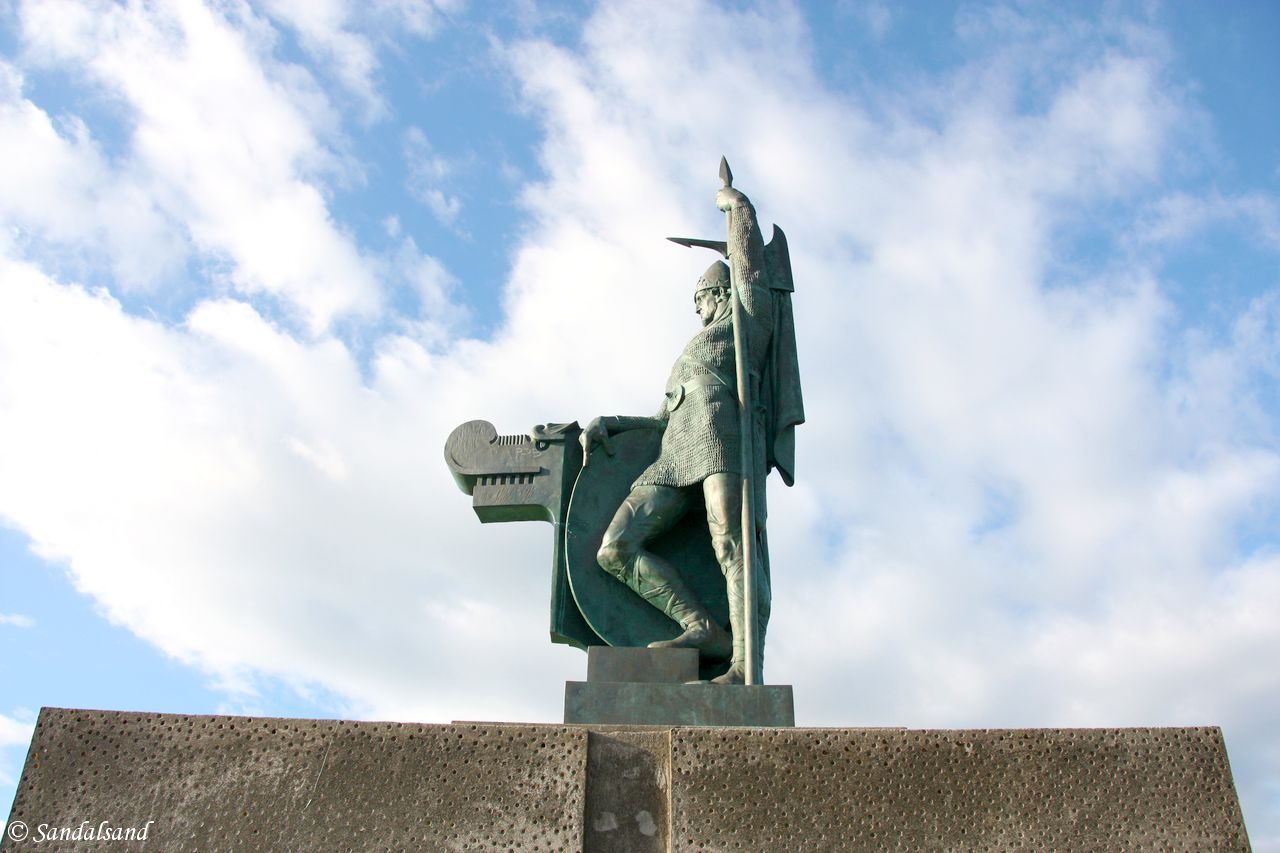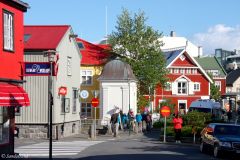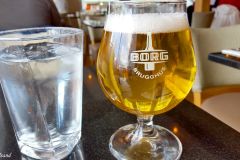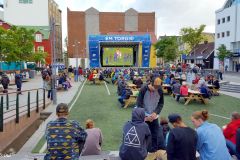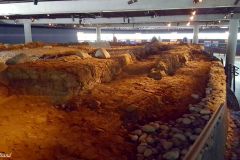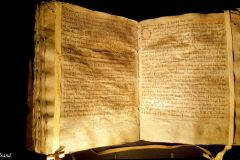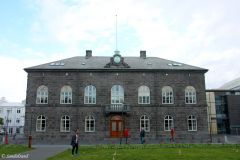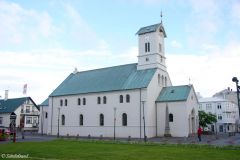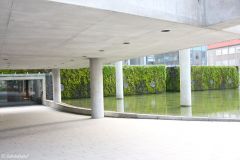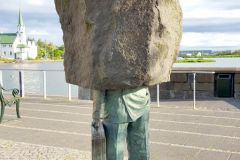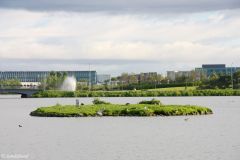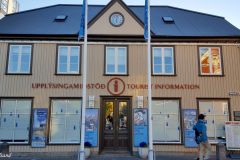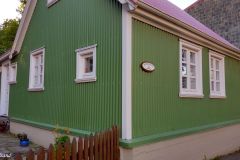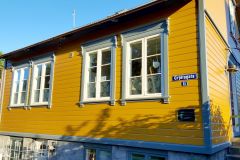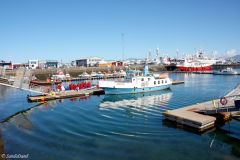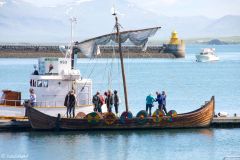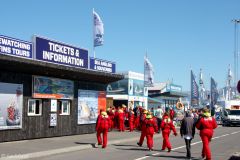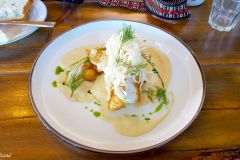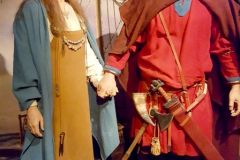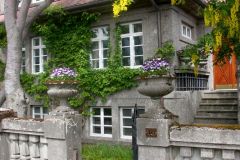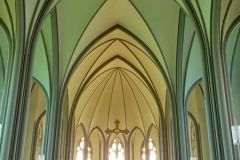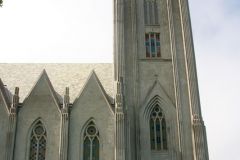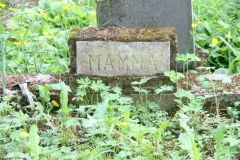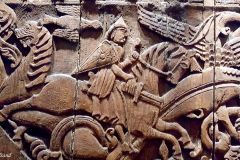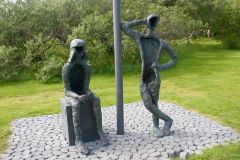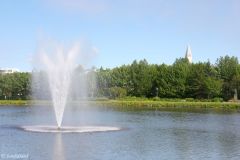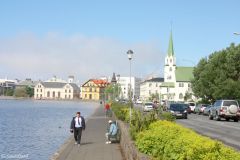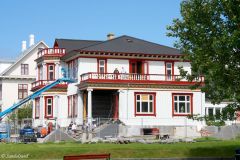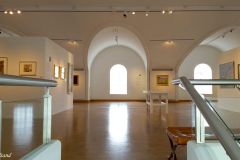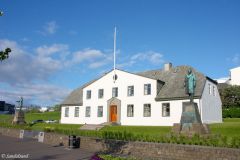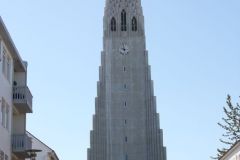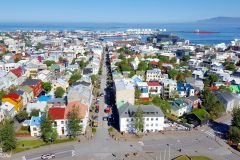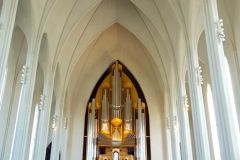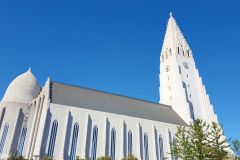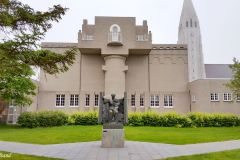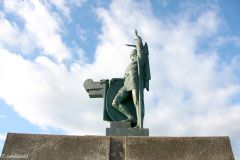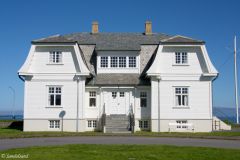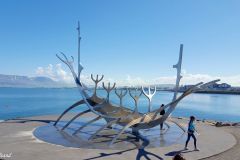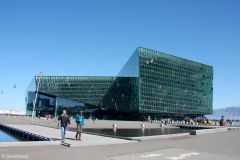Reykjavik is small enough to let you discover most of the sights on foot, and large enough to keep you going for a couple of days at least. In addition it is a very pleasant city to visit.
I had one and a half day available in Reykjavik. I had made a map of attractions before I arrived, adjusted it on the go, and found a way to connect them by means of walking the streets. This worked well for me, and might serve as a guide for others.
The attractions are presented in three parts. The first deals with the city core, the next with attractions to the west and south, the third with attractions to the east and north. After that you will be able to read up on my choice of accommodation and restaurants, before checking out the map and finally the links to my other articles from Iceland at the very end. You may want to zoom in on the map in a separate window as you continue reading.
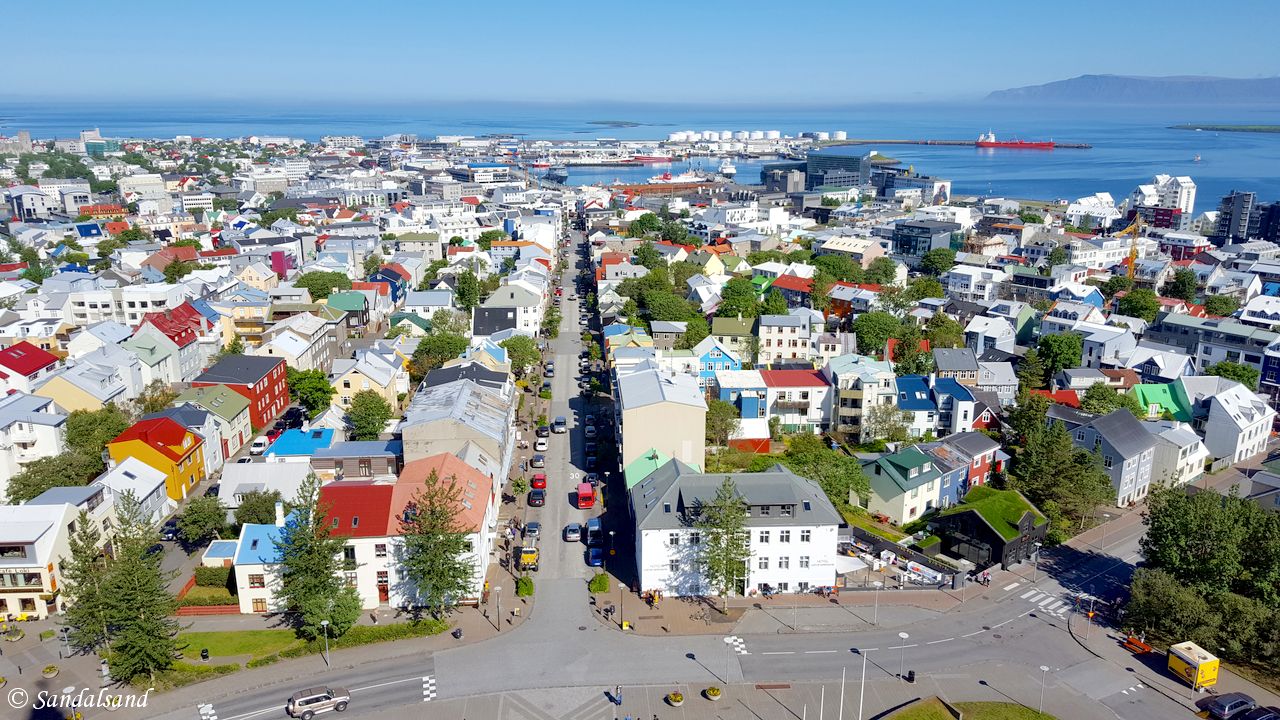
Towards the city centre, seen from the tower of Hallgrimskirkja
First part
We will start this walk on the Ingólfstorg, a square in the middle of everything. In the corner you will find the Tourist Information Centre, a place to drop into to find brochures or ask for assistance. I had the fortune of having picked a guesthouse only 100 metres off the square. Anyway, from here it is a short walk south on Adalstræti past the oldest house in Reykjavik (painted black) onto another square on your left hand and more importantly into the museum on your right.
The Reykjavík 871 +/-2 Settlement Museum is a natural place to visit. Not only does it give you a very useful introduction to the settlement of Reykjavik and Iceland almost 1200 years ago, and a chance to look at some really old manuscripts. It also is the perfect example of how a modern museum should use modern technology.
.
Next, walk along Kirkjustræti (translating to Church street) until you reach the next square, Austarvöllur. You may want to have a look at the artwork of different kinds here, but they are likely most interesting to Icelanders. The rest of us will want to study the dark stone walls of the Alþingishúsið (Parliament House) a classical austere 19th century building with modern wings attached to it. Iceland has a small population, but even the Allthing building is too small, so most offices and meeting rooms are situated around the square in adjacent buildings.
Right next to the parliament we find Dómkirkjan (the cathedral). This is were the bishop of Iceland has his seat. I had not the chance to get inside.
We now conclude this part of the walk by moving past the parliament and cathedral towards the lake called Tjörnin. It is in itself a popular place for a walk, forming a park at the other end. We will get there in the next section. First we want to have a closer look at Reykjavik City Hall. It has large columns on the side facing the lake, it has running water dripping vertically through moss on the western end, and it invites us for a walk along the innermost part of the lake towards the wonderful monument called Monument to the Unknown Bureaucrat. With that I rest my pen.
Almost. From here you will want to crisscross the shopping streets of central Reykjavik on your way back to Ingólfstorg. There are plenty of bars too.
.
I was here during the Euro 2016 football tournament. As a miracle Iceland had qualified and everything was turned upside down, in particular when the results became better and better. On Ingólfstorg a large screen had been set up and so they had in every restaurant and bar. During Iceland’s matches, and I was lucky enough to be here one successful evening, one out of ten Icelanders had left for France, and the rest were watching the game at home or with others on town. Only American tourists were out in the streets understanding nothing.
Second part
If you want to follow my tracks, and I suggest you do, then head slightly uphill from the vicinity of Ingólfstorg. Grjótagata, Mjóstræti and Fischersund are three streets that leads you straight into a residential area of central Reykjavik. You have in the first part seen the commercial buildings downtown, this is something completely different. Take a notice of the colourful houses, the small gardens and narrow streets. Iceland does not have many trees so the colourful exteriors stems from either plastic or more common painted corrugated iron. Some colours are really striking.
Next head down (north) to the Reykjavik Art Museum and have a look inside. If not, continue straight ahead to the Old Harbour and turn left (west). This is a place with monuments, ships, wharves, restaurants and kiosks offering tickets to RIB-boats going on whale watching excursions. They are popular, but I skipped them.
Continue along the harbour until you reach the Saga Museum giving you an insight into Icelandic history. It was a success. The restaurant under the same roof was even more of a success (read more below). The next building is the modern Maritime Museum, which I did not visit.
.
From Saga I backtracked a bit along the harbour until I reached the street called Ægirsgata. It proved a success for it led my way uphill through another type of residential area before ending on top at the Cathedral of Christ the King.
I then walked in a southern direction diagonally across the Old cemetery over to the National Museum of Iceland. They are both definitely worth a visit.
When you leave the museum you will easily find your way down to the lake called Tjörnin. This is the park area of the lake, around the southern end. You will find a number of statues as you walk by and continue along the lake towards the city centre. Take notice of the beautiful building called Fríkirkjan í Reykjavík (Free church). Coming up next to it is the Listasafn Íslands (National Gallery of Iceland) also a must-see in Reykjavik in my opinion.
We are now back in the very centre of Reykjavik and have one more part to finish before we are satisfied.
Third part
This last part of my Reykjavik walk takes place on the western part of the city core. Like the streets mentioned in the beginning of part two, this is also a walk slightly uphill. We will start at the bottom in the street called Lækjargata, somewhat burdened by traffic. Coming in from Lake Tjörnin you will pass a series of very nice villas and buildings when you are heading north.
One of them is called Stjórnarráðið (Government House). It was built as the first prison in Iceland but now serves as the prime minister’s office and the headquarters of the Icelandic Government. Not the same size as another famous white-washed house, it does have the classic look of respect and authority.
From here we walk uphill, just like all other tourists, up the street of Bankastræti which changes name to Laugavegur and branches off to the right into Skólavörðustígur. Try pronouncing that one! These streets are filled with fascinating buildings and shops – a lot of shops.
.
Spend as much time here as you want, then continue up the Skólavörðustígur. At the far end of the street you will see the monumental church called Hallgrimskirkja. It is perhaps Reykjavik’s most famous landmark. Look inside and take the elevator to the top for wonderful panoramic views in all directions. The statue of the discoverer of America, Leif Eriksson, in front of the church is also much photographed.
Next to the church you will find Einar Jónsson Museum. If you decide to drop the interior exhibition, do not miss the sculpture park in the garden. Jónsson is Iceland’s most famous sculptor.
.
From the museum and church you will now want to continue downhill, in a northernly direction facing the fjord and the huge Esjan mountain on the other side. You may want to take the Frakkastigur street downhill to the next attraction.
I had a particular interest in taking a slight detour to the east, to Höfði House. This mansion served as the neutral meeting place for presidents Ronald Reagan and Michail Gorbachev in 1986. The summit marks the beginning of the end of the Cold War, and I wanted to stand on the same steps as these two famous politicians.
The Höfði House is right on the seafront and if we continue towards the city centre we will pass the sculpture called Sólfarið (Sun Voyager). It looks like a viking ship but is in fact a dream machine.
Anyway, from here we can’t miss the large green glass building called Harpa. It is a combined concert hall and conference centre, and is to be admired inside and out.
From this modern-day architectural gem we will continue and end our walk where it all began, in a manner of speaking, on the hill called Arnarhóll. On top of the grassy hill there is a statue of Ingólfr Arnarson, the Norwegian who first settled on Iceland permanently. He founded and gave name to Reykjavik i 874.
Places marked on the map, but not visited
There are a quite a few places I had identified before I arrived, or took a notice of during my visit. Some of them will have to wait till the next time I make it to Reykjavik. Here they are:
- Árbær, Reykjavik Open Air Museum
- Fossvogsdalur, a recreational area south of the centre
- Videy, a small island outside Reykjavik
- Imagine peace tower, on that island.
- Gróttuviti lighthouse, beyond walking distance to the west
- Nordic House, a cultural institution
Conclusions
Everything works out better walking city streets if the weather is nice. In Reykjavik that is not always the case. I was lucky and had some warm and sunny days here. In any case, it proved to be a very nice little capital. About 60% of the nation’s 300,000 inhabitants live in or close to city. The centre is small enough to be walked on foot, it has a number of museums you might want to have a look into, there are an unusual amount of sculptures (traditional and modern) scattered around on squares and in the parks and pavements, and there are lots of restaurants and bars.
For practical information, continue reading, and do also have a look at my introductory article from Iceland.
Accomodation
On this visit I spent three nights in Reykjavik, the first at the Treasure B&B and the last two at Aurora. It should have been the other way round but it was a matter of keeping a budget.
Reykjavík Treasure B&B: “A delightful little guesthouse with the best location in town”. Rooms upstairs or in the basement. My basement room spacious and very neat. The breakfast is served on the ground floor and has everything you would like to see on a breakfast table. Clean and hospitable. The immediate surroundings are very quiet but the main attractions of the city centre is just two minutes away on foot. Parking can be a challenge. The free wifi worked fine. (Book it.)
Aurora Guesthouse: “Very basic and boring”. I had a single room with shared bathroom and kitchenette (with two other rooms). The bedroom was very small and utterly boring. Nothing had been made to make it nice. The basement breakfast room was likewise, but the breakfast itself was decent. This is a place in need of a human touch. There is free parking in the neighbourhood, but you might have to look around to find an available spot. Plus for a working wifi. (Book it.)
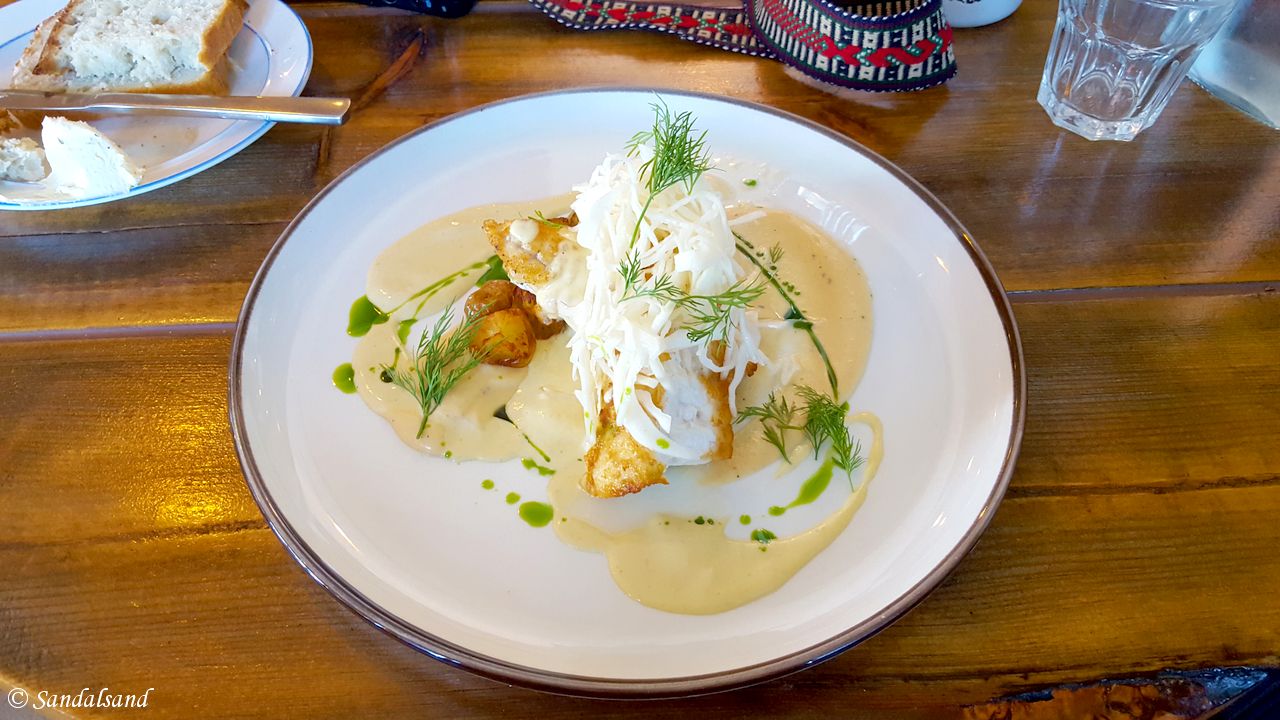
A very tasty plate of wolffish for lunch
Restaurants
As usual there was a mix of recommended and arbitrary eating places during my visit. I posted the following evaluations on my Tripadvisor profile:
Geysir Bistro: “Safe choice in the middle of the tourist track”. Perfect location, a soothing menu (no scary Icelandic specialities), nice and attentive waitresses and good cooking. There is nothing wrong about this place. Nothing exciting either. The tourist information office is under the same roof.
Matur og Drykkur: “What a pleasant surprise”. I actually came for the Saga museum but discovered this restaurant inside the same building. It was time for lunch and the fresh fish on today’s menu looked promising. A wonderful wolffish with potatoes and veggies. The sauce tasted a lot better than it looked. Very good service, relaxing atmosphere in delicate rustic surroundings. Highly recommended! Be sure not to miss the museum.
Kol Restaurant: “Good food and service”. This is a place to bring friends or for business. It receives good recommendations on Tripadvisor and that it the reason I came. I am not going to tear down the impressions of others for they are by and large correct.
Þrír frakkar: “A slight disappointment”. This was a restaurant with a very good score on TripAdvisor and I was lucky to get a table right away. It is a nice little informal bistro-like place in a residential neighbourhood. The waiters were attentive and the menu (and prices) was Icelandic. The traditional shark appetizer was quite boring actually. Tasteless but interesting nonetheless. The main course was horse. We should definitely eat more of it. This horse was quite tender. The chips were crispy on the outside and doughy inside. The conclusion is that it was a mixed experience. A large plus for a very exciting menu. I would like to come back to taste the other choices.
Read more
The map below shows the places I visited (and some more) and routes I travelled on Iceland, spending four nights in the country. I advise you to open the map in a new window, remove the ticks for places and road trips outside Reykjavik and concentrate on the sights within the city centre. Click the remaining markers for a short text and even an odd picture.
The series from Iceland consists of these articles:
(1) How to get the most out of four nights in Iceland
(2) Reykjavik attractions (THIS)
World Heritage Site #1152 – Thingvellir National Park
